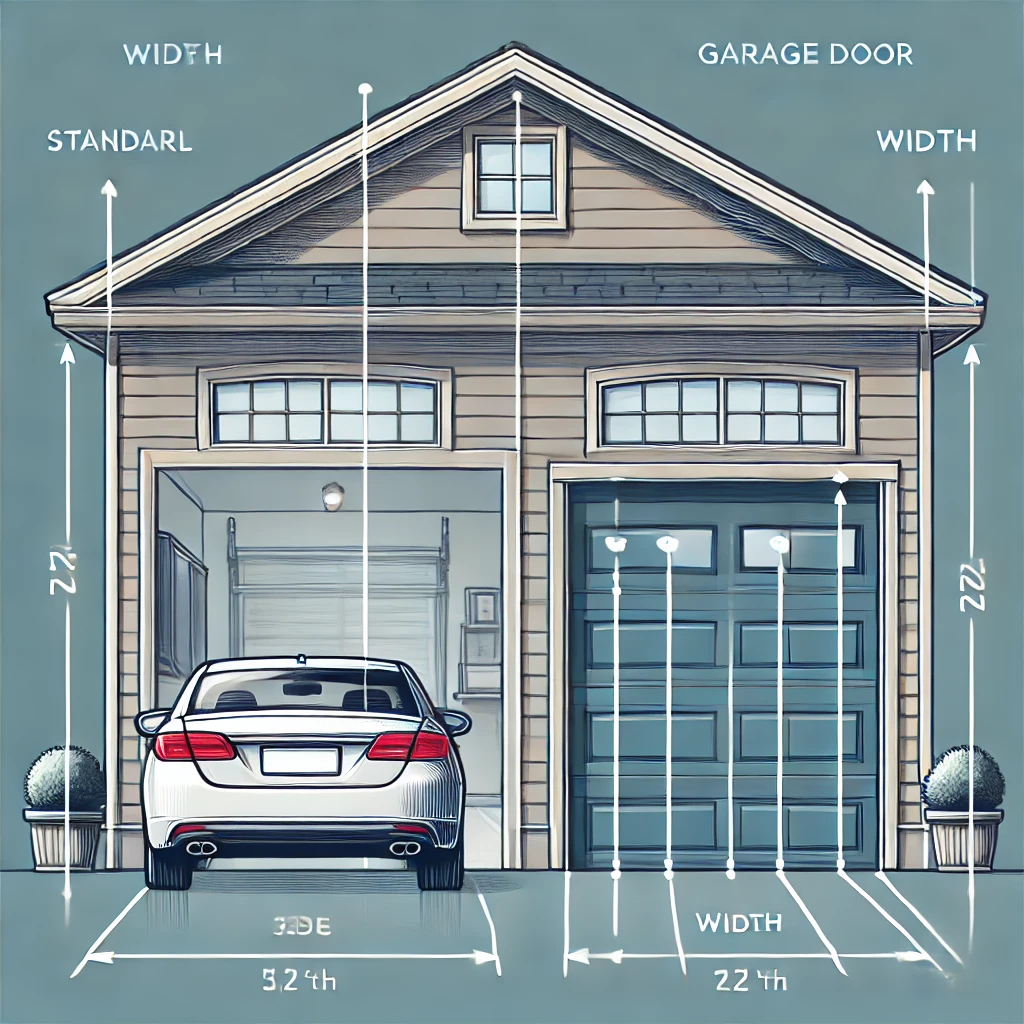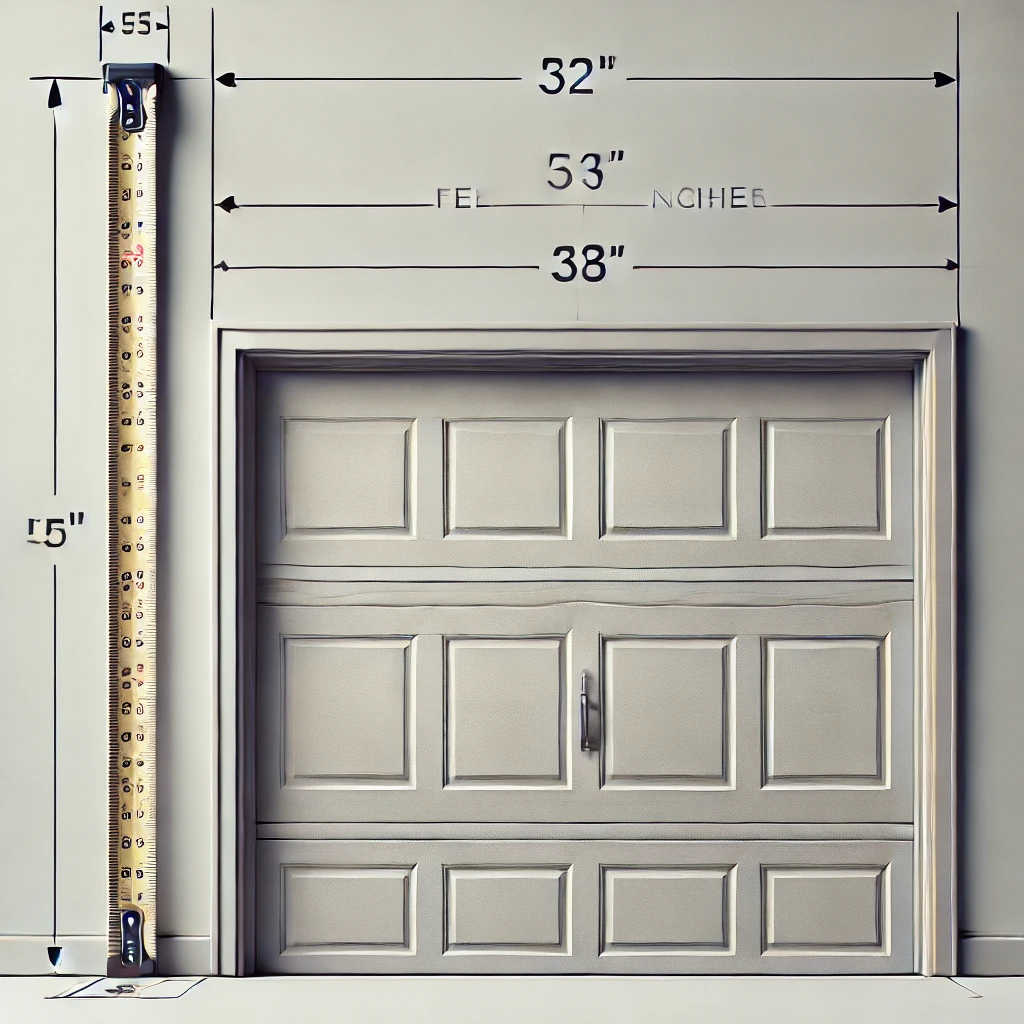Garage Door Width: Is Yours Too Small? Find Out Now!

Choosing the right garage door width is a crucial decision that affects both the functionality of your garage and the overall look of your home. Whether you park a single vehicle or accommodate multiple cars, the width of your garage door must align with your space, vehicle size, and future needs. This guide delves into the standard garage door widths, how to measure for a new door, and tips for selecting the ideal width based on your specific requirements. We’ll explore what works best for different setups and preferences, from the common 8-foot and 9-foot single-car doors to the more spacious 16-foot double-car doors. Keep reading to discover how to choose the perfect garage door width. This width balances aesthetics with practicality, ensuring a seamless fit for your home and a hassle-free experience every time you drive in or out. Understanding Standard Garage Door Widths Garage doors come in a range of standard widths designed to accommodate various vehicles and garage setups. Here’s a breakdown of the most common sizes: Single-Car Garage Doors Double-Car Garage Doors Custom Garage Doors If your garage has unique dimensions or if you have specific needs that standard sizes can’t accommodate, custom garage doors are a viable option. Custom doors can be made to any width and are particularly useful for garages with irregular shapes or those needing a door that can handle oversized vehicles like RVs or boats. How to Measure Your Garage Door Width Accurate measurements are crucial when selecting a new garage door. A precise fit ensures the door functions smoothly, provides adequate clearance, and enhances the overall appearance of your home. Here’s a step-by-step guide to help you measure your garage door width correctly: Step 1: Clear the Area Before you begin measuring, it’s essential to clear the area around the garage door. Remove any vehicles, tools, or other items that might obstruct your view or interfere with your ability to take accurate measurements. A clutter-free space ensures you can measure the entire opening width without hindrance, giving you the most precise reading possible. Step 2: Measure the Opening Width Using a tape measure, carefully measure the width of the garage door opening from one side to the other. This measurement should be taken from the inside of the door frame at the widest point, as walls can sometimes be uneven or have slight variations. Ensure the tape measure is level and straight to avoid any inaccuracies. Record the measurement to the nearest inch, as even a slight discrepancy can affect the door’s fit and operation. Step 3: Consider the Frame In addition to measuring the opening itself, it’s essential to account for the width of the garage door frame. The frame includes the space between the edge of the opening and the surrounding wall, and it plays a crucial role in the overall installation. Measure both the left and right sides of the frame to determine if there’s enough room to accommodate the tracks, springs, and other hardware. This step ensures that your new door will fit snugly within the available space without any adjustments or modifications. Step 4: Double-Check Measurements Accuracy is key when measuring for a new garage door. Double-check all the dimensions you’ve recorded to ensure that your measurements are precise. Measure each dimension at least twice to confirm consistency. If there are any discrepancies, remeasure until you are confident in the accuracy. If you need clarification on any aspect of the measurement process, consider enlisting a professional to measure the space. Professional measurements provide peace of mind and prevent potential issues during installation. Choosing the Right Garage Door Width Selecting the correct width for your garage door depends on several factors, including the size of your vehicle, the layout of your garage, and your personal preferences. Here are some tips to help you choose the right width: Consider Your Vehicle Size An 8—or 9-foot wide door may be sufficient if you have a standard-sized vehicle. However, driving a larger vehicle like an SUV, truck, or van might require a wider door. Remember that wider doors offer more room for maneuvering, which can be especially important if your garage is narrow or you have limited clearance on either side of the door. Think About Future Needs When selecting a garage door width for your garage door repair, consider your future needs as well. If you plan to upgrade to a larger vehicle or anticipate needing more storage space in your garage, opting for a wider door now can save you the hassle of upgrading later. Additionally, wider doors can make it easier to add features like a workbench, shelving, or bike racks along the sides of your garage. Evaluate Your Garage Layout The layout of your garage plays a significant role in determining the appropriate door width. A narrower door might be necessary if your garage is narrow or has obstructions like pillars or storage areas along the walls. On the other hand, if you have a spacious garage with plenty of room on either side, a wider door could enhance the usability of the space. Balance Aesthetics and Functionality While functionality is crucial, don’t overlook the aesthetic impact of your garage door. A door that’s too wide for your home’s proportions can look out of place, while a door that’s too narrow might not provide the visual impact you desire. Consider your home’s overall design and choose a door width that complements its style while meeting your practical needs. Additional Considerations for Garage Door Width Insulation and Climate Control The width of your garage door can also affect its insulation properties. Wider doors often have more panels and joints, increasing heat loss if not properly insulated. If you live in a region with extreme temperatures, consider investing in an insulated garage door that provides better climate control and energy efficiency. Garage Door Opener Compatibility Ensure that your garage door opener is compatible with the width of your door. Wider and heavier doors require more powerful
4 Jaw-Dropping Reasons Garage Door Height Is More Important Than You Think!

Selecting the right garage door height enhances your home’s functionality, security, and overall appearance. Whether you’re installing a new door or replacing an existing one, understanding the standard sizes and how to measure your space accurately ensures that your garage door fits perfectly and operates smoothly. In this guide, we’ll explore the standard sizes for single- and double-car garage doors, discuss why choosing the correct height is essential, and provide detailed instructions on measuring your garage door opening. We’ll also cover additional considerations like headroom, obstructions, and material choices that can impact your decision. Keep reading to learn everything you need to know about garage door height. This information will help you make an informed choice that complements your home’s style and meets your practical needs. What Are the Standard Garage Door Sizes? Garage doors come in various sizes to suit different garage types, vehicle sizes, and homeowner preferences. Understanding the standard garage door sizes will help you make an informed decision: Should You Replace or Repair Your Garage Door? Deciding whether to replace or repair your garage door is an important consideration that depends on several factors. Here’s a detailed look at what you should consider: Why Garage Door Size Matters: Four Key Reasons Ensuring Proper Fit and Functionality Selecting the correct garage door size ensures the door fits within the frame and operates smoothly. A door that is too small may leave gaps that allow water, debris, or pests to enter, while a too-large door can be difficult to install and may not fit properly within the opening. Proper sizing ensures that your door operates efficiently, providing a snug fit that protects your garage’s contents and maintains its structural integrity. Enhancing Aesthetic Appeal Your garage door plays a significant role in your home’s curb appeal, as it’s often one of the most prominent features visible from the street. Choosing a door proportionate to your home’s facade enhances the overall aesthetic and creates a harmonious look. A well-sized door that complements your home’s architectural style—whether modern, traditional, or rustic—can significantly increase its visual appeal and market value. Boosting Insulation and Energy Efficiency A garage door that fits perfectly within its frame is essential for maintaining insulation and energy efficiency. Gaps around the door can cause drafts, leading to temperature fluctuations in your garage and affecting the comfort of adjacent rooms. Over time, this can increase your energy bills as your HVAC system works harder to maintain a stable indoor temperature. Choosing the right size and an insulated door can improve your home’s overall energy efficiency, making it easier to control heating and cooling costs. Maximizing Safety and Security A correctly sized garage door is crucial for ensuring the safety and security of your home. A door that doesn’t fit properly may not close fully, leaving your garage vulnerable to intruders. Also, improper sizing can lead to mechanical issues, such as the door becoming stuck or misaligned, posing safety hazards. By selecting the right size, you ensure your garage door is secure and functions smoothly, protecting your belongings and family. How to Measure Your Garage Door for the Perfect Fit Accurate measurements are essential when ordering a new garage door. Here’s a step-by-step guide to help you measure your garage door opening: Step 1: Measure the Width Start by measuring the width of the garage door opening from the inside of one side to the other. Use a tape measure and measure at the widest point. If your garage walls are uneven, take multiple measurements to ensure accuracy. Record the largest measurement to ensure the door will fit properly. Step 2: Measure the Height Next, measure the height of the garage door opening from the floor to the top of the door frame. As with the width, measure at the tallest point to account for any irregularities in the floor or ceiling. Accurate height measurements ensure the door closes entirely and operates smoothly. Step 3: Measure the Side Room and Headroom The side room refers to the space between the edge of the garage door opening and the wall. Measure both sides to ensure enough room for the tracks and springs. Typically, you’ll need at least 3.5 inches on each side. Headroom is the space between the top of the door opening and the ceiling. This area is essential for the door’s track system and the garage door opener. Standard doors require at least 10 to 12 inches of headroom, but low-clearance options are available if your space is limited. Additional Considerations When Measuring a Garage Door Opening Checking for Obstructions Before installing a new garage door, inspect the area for any obstructions that could interfere with its installation or operation. Common obstructions include pipes, electrical outlets, light fixtures, and storage shelves. These may need to be relocated or adjusted to ensure the garage door repair or installation can be completed properly and operate without hindrance. Taking Note of the Floor Slope If your garage floor slopes intentionally for drainage or due to settling, it can affect how the door sits when closed. Measure the slope by checking the difference in height at various points along the floor. A significant slope may require adjustments during installation or a specialized bottom seal to prevent gaps when the door is closed. Other Factors to Consider Frequently Asked Questions (FAQs) What is the height of a standard garage door? The standard height of a garage door is 7 feet (213 cm), typical for most residential garages. This height accommodates standard vehicles like sedans, SUVs, and light trucks. Some homes may opt for an 8-foot door, especially if they have larger vehicles or require more clearance for overhead storage. What is the ideal height of a garage? The ideal height of a garage is around 9 to 10 feet. This provides enough clearance for most vehicles, including taller SUVs and trucks, and allows space for overhead storage or garage door openers. If you plan to install a car lift, a height of 12
